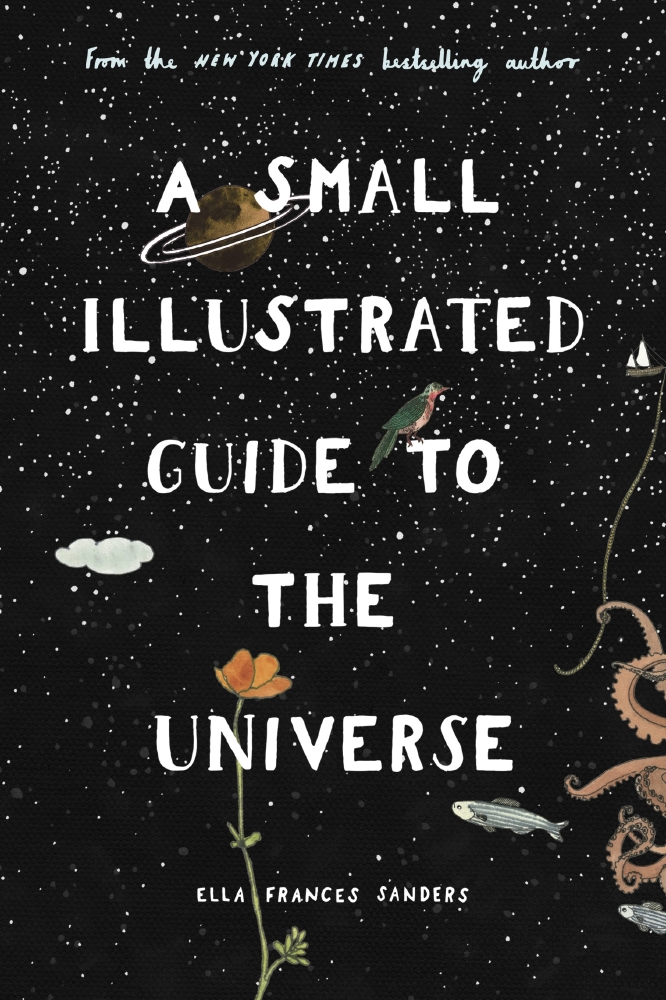Many people assume ‘air’ is just oxygen, the stuff we need to keep going, but oxygen actually only accounts for 21 percent of what you’re breathing in. The rest of your lung soup is nitrogen (78 percent) along with some more unusual ingredients: other gases, contaminants from air pollutants, water molecules, dust, microbes, spores from plants, cosmic dust. You will in fact be inhaling particles from a meteoroid at some point this year too.

A Small Illustrated Guide to the Universe
Our solar system (the glaring sun, surrounded by its orbiting planets and countless other objects) lies within a galaxy called the Milky Way, galaxies being huge, huge systems of stars separated from other similar systems by vast regions of space. The Milky Way may not be news to you, but what might be news is that in the September of 2014, a group of astronomers realised that the Milky Way was part of a group of galaxies one hundred times larger than previously thought, part of a collection. These collections of galaxies are known as ‘superclusters’, and the one we live in was named Laniakea, which is Hawaiian for ‘immeasurable heaven’.
Any at given time, clouds cover about two thirds of our planet, but even after decades upon decades of gazing upwards, the movements of clouds are still quite difficult for meteorologists to predict and map. They form when water vapour or ice crystals cling onto microscopic particles in the atmosphere, things like smoke or dust or salt, and when you put millions and millions of these clinging droplets together, you have a cloud, one that could easily weigh, although hard to believe, the equivalent of a hundred large elephants.
There is no universally accepted definition of a mountain, but most geologists classify them as such if they rise at least 300 meters (1,000 feet) above the surrounding area. Mountains cover about 20 percent of Earth’s surface, are home to around 10 percent of the world’s population, and over half of humanity depends on them for water. Our destructive human activities on the planet are causing mountain glaciers to melt, rapidly now, which means huge water weight is being redistributed from high mountain altitudes to low ones, and this is actually having an effect on the very spin, the rotation, of Earth.
Earth and Moon are in a long-distance relationship—holding onto each other, something we could definitely call mutual attraction. As the Moon orbits Earth, Earth exerts a gravitational force upon it, a constant pull towards us, and this is balanced quite perfectly by the force of the Moon pulling away from Earth. It is the same sort of thing as two people holding onto each other’s hands and spinning madly around—you pull this way, I’ll pull that way, let’s see how long we can remain upright.
An ‘astronomical year’ is the time it takes for Earth to orbit once around the sun, but not one of the forty or so calendars in use around the world matches up perfectly to this. The most widely-used calendar today is the Gregorian one, which took over from the Julian calendar in 1582. They only differ in length by eleven minutes, but in order to complete the change, we needed to delete ten days from history, so it is as if the days between October 5th and October 14th 1582 never happened. Then in 1967, to make matters more confusing, the atomic clock became the most accurate keeper of time we’ve ever known. Even so, we still have to add ‘leap seconds’ on now and again in order to keep atomic time (clocks) in line with astronomical time (planets), and consequently around eight minutes per decade will contain sixty-one seconds, not the usual sixty.
Time moves in one direction—it is asymmetrical, not symmetrical. A British astronomer called Arthur Eddington realised in 1927 that if time were symmetrical, the world would be absolutely absurd. Imagine, if you will, a video of the planets orbiting the sun, played first forwards and then backwards—everything would look fine and good and normal, either way you played it. But if a video of someone dropping a book onto the floor were played backwards, the book would seem, bizarrely, to fall upwards. It is this direction of time which means that we can remember the past, but cannot remember the future.

